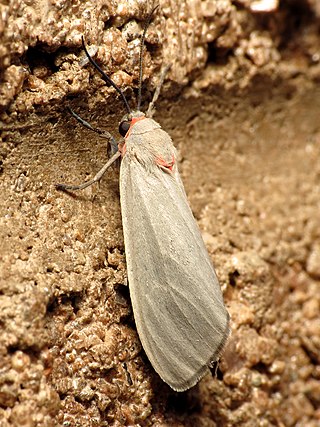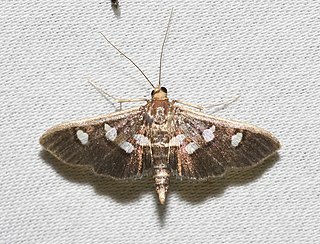
Pygarctia is a genus of moths in the family Erebidae.
Pygarctia spraguei, also known as Sprague's pygarctia or Sprague's tiger moth, is a moth of the family Erebidae. It was described by Augustus Radcliffe Grote in 1875. It is found in North America from the Great Plains of southern Canada to Texas, westward to Utah, eastward to Indiana and Louisiana.

Metalectra discalis, the common fungus moth, is a moth of the family Erebidae. The species was first described by Augustus Radcliffe Grote in 1876. It is found in North America from Wisconsin to Quebec and Maine, south to Florida, west to Texas and Missouri, north to Ontario.
Pygarctia angelus is a moth in the family Erebidae. It was described by Harrison Gray Dyar Jr. in 1907. It is found in Mexico.
Pygarctia eglenensis, the gray-winged pareuchaetes, is a moth in the family Erebidae. It was described by James Brackenridge Clemens in 1861. It is found in the US states of Texas and Florida.
Pygarctia flavidorsalis is a moth in the family Erebidae. It was described by William Barnes and James Halliday McDunnough in 1913. It is found in the US states of Arizona and Texas. There is also a record for Oklahoma.
Pygarctia haematodes is a moth in the family Erebidae. It was described by Harrison Gray Dyar Jr. in 1921. It is found in Mexico.
Pygarctia lorula is a moth in the family Erebidae. It was described by Harrison Gray Dyar Jr. in 1914. It is found in the US state of New Mexico.
Pygarctia matudai is a species of moth in the family Erebidae. It was described by Carlos Rommel Beutelspacher in 1978. It is found in Mexico.

Pygarctia murina, the mouse-colored euchaetias, is a moth in the family Erebidae. It was described by Richard Harper Stretch in 1885. It is found in the United States in south-western Utah, from southern Colorado to south-eastern California and in southern Texas.
Pygarctia neomexicana is a moth in the family Erebidae. It was described by William Barnes in 1904. It is found in the US states of Texas, Arizona, Colorado, New Mexico and Utah.

Pygarctia roseicapitis, the red-headed pygarctia moth, is a moth in the family Erebidae. It was described by Berthold Neumoegen and Harrison Gray Dyar Jr. in 1893. It is found in Mexico and in the United States from southern Arizona to Texas.

Chrysendeton medicinalis, the bold medicine moth, is a moth in the family Crambidae. It was described by Augustus Radcliffe Grote in 1881. It is found on North America, where it has been recorded from Alabama, Florida, Georgia, Illinois, Indiana, Kentucky, Maryland, Mississippi, North Carolina, Ohio, Pennsylvania, South Carolina, Tennessee, Texas and West Virginia.

Desmia subdivisalis is a species of moth in the family Crambidae. It was described by Augustus Radcliffe Grote in 1871. It is found in the West Indies, Mexico and the United States, where it has been recorded from Florida to New Mexico, Illinois, Maryland and California.

Baileya australis, the small baileya moth, is a moth of the family Nolidae. The species was first described by Augustus Radcliffe Grote in 1881. It is found in North America, where it has been recorded from Quebec and New York to Florida, west to Texas, north to North Dakota and Ontario.
Eulepte anticostalis is a moth in the family Crambidae. It was described by Augustus Radcliffe Grote in 1871. It is found in North America, where it has been recorded from Florida to North Carolina and west to Texas. It is also found on Puerto Rico.

Hyperstrotia secta, the black-patched graylet moth, is a moth of the family Erebidae. The species was first described by Augustus Radcliffe Grote in 1879. It is found in North America, where it has been recorded from Alabama, Arkansas, Florida, Georgia, Illinois, Indiana, Kentucky, Louisiana, Maryland, Massachusetts, Mississippi, New Hampshire, New Jersey, New York, North Carolina, Ohio, Oklahoma, South Carolina, Tennessee, Virginia and West Virginia.

Metalectra tantillus, the black fungus moth, is a moth of the family Erebidae. The species was first described by Augustus Radcliffe Grote in 1874. It has been recorded from the US states of Alabama, Florida, Georgia, Illinois, Iowa, Kentucky, Maryland, Mississippi, New Jersey, North Carolina, Ohio, Oklahoma, Pennsylvania, South Carolina, Tennessee, Texas, West Virginia and Wisconsin.

Lygropia plumbicostalis is a species of moth in the family Crambidae. It was described by Augustus Radcliffe Grote in 1871. It is found in the United States, where it has been recorded from Arizona, Florida and Texas.
Mecyna submedialis, the orange-toned mecyna moth, is a moth in the family Crambidae. It was described by Augustus Radcliffe Grote in 1876. It is found in North America, where it has been recorded from Ontario and Michigan, south to Florida and west to Arkansas. It has also been recorded from Alberta.










